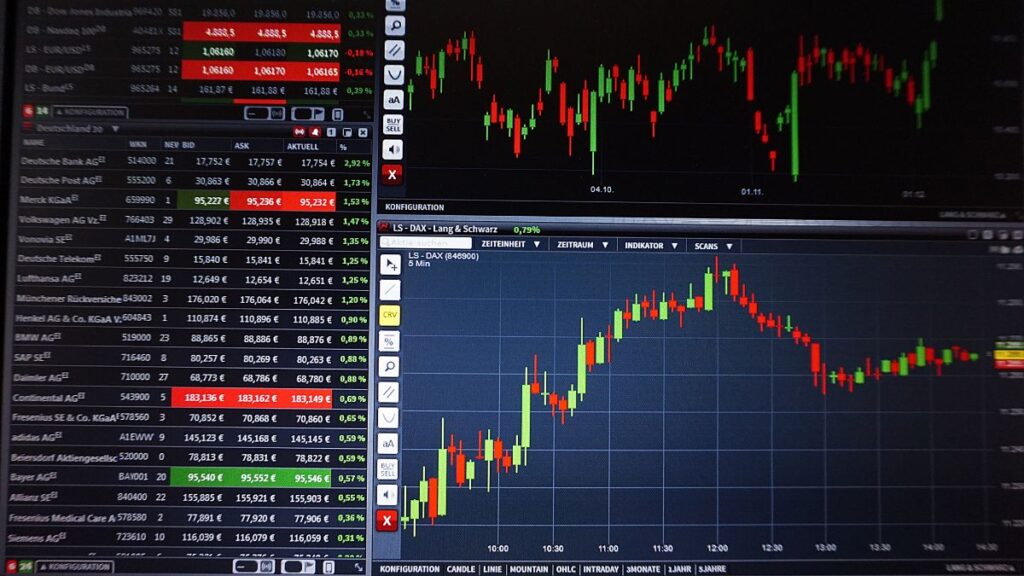Institutional trading platforms are purpose-built for hedge funds, asset managers, and banks to manage large, complex, and regulated trades. Prop firms, by contrast, use retail-grade platforms enhanced with institutional-style risk controls to scale funded trader operations. Here’s how they differ, where they overlap, and why it matters.
What Is an Institutional Trading Platform?
Institutional trading platforms are advanced Execution Management Systems (EMS) and Order Management Systems (OMS) used by regulated financial institutions to execute large volumes of trades with direct market access, dark pool connectivity, and algorithmic routing.
One of the most widely recognized examples is Bloomberg EMSX, part of Bloomberg’s Execution Management Solutions suite, which offers:
- Multi-asset order routing across equities, fixed income, derivatives, commodities, and FX.
- Pre-trade cost analysis and post-trade analytics to optimize execution quality.
- Dark pool access to tap hidden liquidity.
- Customizable integrations with third-party and in-house systems for end-to-end workflows.
- Compliance and audit readiness across all asset classes and execution styles.
Bloomberg’s EMSX operates within the Bloomberg Terminal environment, which also provides real-time market data, analytics, and secure communications. As of 2022, the Bloomberg Terminal had approximately 325,000 subscribers worldwide, and annual subscription costs typically range from $24,000 to $32,000 per user.
What Platforms Do Prop Firms Use?
Prop firms typically operate on advanced retail trading platforms such as MetaTrader 4 (MT4), MetaTrader 5 (MT5), MatchTrader, or NinjaTrader, often enhanced with proprietary risk management plugins and funding administration systems.
Unlike institutional EMS/OMS systems, these platforms are:
- Accessible globally — allowing rapid onboarding of traders in different regions and regulatory environments.
- Customizable with risk controls — plugins can automatically enforce daily loss limits, max drawdown rules, and profit target conditions.
- Integrated with APIs — enabling automated reporting, trader performance tracking, and payout management.
- Compatible with broker infrastructures — connecting to liquidity providers that support leveraged retail products like FX, CFDs, and crypto.
Institutional vs Prop Firm Platforms — Side-by-Side
| Feature | Institutional Platform | Prop Firm Platform |
| Core Software | Bloomberg EMSX, FlexTrade, Charles River IMS | MT5, MatchTrader, cTrader + custom plugins |
| Pricing | $24K–$32K+ per seat/year | Significantly lower, often flexible subscription |
| Functionality | Multi-asset routing, compliance, APIs | Risk enforcement, capital allocation, analytics |
| Users | Regulated institutions | Proprietary firms & funded trader networks |
| Enforcement Mechanisms | Regulatory compliance, audit trails | Daily loss limits, funded performance rules |
Why Prop Firms Don’t Use Institutional Platforms
Prop firms rarely adopt true institutional EMS/OMS systems because their business model and trader base don’t require the same infrastructure as banks or hedge funds.
Key reasons include:
- High cost — Enterprise EMS licenses can range from $50,000 to over $200,000 per user per year, far exceeding the cost-efficiency needs of most prop firms.
- Market focus — Most prop traders operate in retail-accessible markets like FX, CFDs, indices, and crypto, which do not require direct exchange membership or dark pool access.
- Trader accessibility — Platforms like MT5 or MatchTrader allow for rapid onboarding of global traders with minimal training.
- Regulatory scope — Prop firms enforce internal risk rules but do not need the full compliance modules and audit trails required in regulated institutional trading.
Institutional Features Prop Firms Still Use
While they bypass full-scale institutional EMS/OMS systems, prop firms adopt institutional-style risk and analytics tools to manage funded trader operations effectively.
Examples include:
- Real-time risk management dashboards — monitoring positions, enforcing daily loss limits, and triggering auto-liquidations when thresholds are hit.
- Trade performance analytics — tracking metrics like profit factor, win rate, and drawdown for funding and scaling decisions.
- Multi-trader capital allocation systems — distributing firm capital across active accounts with configurable risk parameters.
- Automated trade copying — replicating profitable strategies across multiple accounts for portfolio scaling.
Benefits of Institutional Platforms (For Actual Institutions)
Institutional-grade trading systems give regulated financial entities the speed, liquidity access, and compliance infrastructure needed to operate at scale in global markets.
Core advantages include:
- Ultra-low-latency execution — essential for large trades where milliseconds can impact pricing.
- Multi-asset global access — trade equities, fixed income, derivatives, commodities, and FX from a single platform.
- Integrated compliance reporting — automated audit trails, regulatory filings, and trade surveillance to meet SEC, MiFID II, and other rules.
- Direct market access (DMA) and dark pool routing — enabling large, discreet transactions without disrupting market prices.
Benefits of Retail Platforms for Prop Firms
Retail-grade trading platforms make prop firms accessible, scalable, and operationally efficient for funding traders worldwide.
Key advantages include:
- Global trader onboarding — intuitive interfaces and low hardware requirements make it easy to recruit traders anywhere.
- Plug-and-play broker connections — seamless integration with liquidity providers specializing in leveraged retail products like FX and CFDs.
- Built-in charting and trade execution tools — allowing traders to analyze markets and place trades from one interface.
- Affordable licensing and customization — significantly lower costs than institutional EMS/OMS platforms, with flexible plugin options for risk management.

Market Context—Prop Firms by the Numbers (2025 Data)
- The global proprietary trading firm market was valued at $20 billion in 2021 and is projected to grow at a 7% CAGR from 2022 to 2028.
- Payout splits for successful traders typically range between 60%–80% of profits, with the median around 75%.
- Less than 15% of traders in prop firms consistently generate profits over a year, and the failure rate in the first six months is about 65%.
- The most common leverage ratio offered is 10:1, with some firms allowing up to 100:1.
- 85% of prop firms provide real-time risk management tools to monitor positions and enforce rules.
- Platform adoption is dominated by MetaTrader 5 and cTrader, with around 70% of firms using automated or algorithmic systems.
- The most traded asset classes include forex (65%), futures (55%), and options (45%), while cryptocurrencies account for roughly 15% of volume.
- The average funded account size for beginners is around $50,000, while top traders often manage accounts exceeding $100,000.
- The average daily trading volume across prop firms exceeds $1 billion globally.
Sources:
- WorldMetrics – Prop Firm Statistics 2025
- Gitnux – Prop Firm Statistics 2025
- LiquidityFeed – Top Prop Trading Platforms for Brokerages 2025
Does Transitioning from Prop to Institutional Platforms Matter?
Yes. Moving from a prop firm environment to an institutional desk requires mastering compliance workflows, advanced order routing, and multi-asset execution logic, not just consistent trade performance.
- Compliance depth — institutional traders work under strict regulatory frameworks (SEC, MiFID II) with mandatory reporting and audit trails.
- Platform shift — transitioning from retail-focused platforms like MT5 or cTrader to enterprise EMS/OMS systems such as Bloomberg EMSX or FlexTrade.
- Execution differences — institutional desks often use DMA (Direct Market Access), smart order routing, and dark pool execution strategies.
Prop firm experience develops discipline, risk management, and technical skills, but institutional roles demand an additional layer of regulatory, operational, and market-structure expertise.
Final Takeaway
Institutional trading platforms are engineered for regulated financial giants with deep compliance needs, while prop firms achieve similar control through retail trading platforms enhanced by institutional-style risk systems. Traders aiming to grow their careers should master both environments to remain competitive.
Ready to Trade Like a Pro?
At MasterFunders, you can prove your skills, pass our challenges, and get funded with up to $200,000 while keeping up to 90% of your profits. With lightning-fast execution, flexible trading rules, and the industry’s most competitive profit targets, there’s never been a better time to level up your trading career.
Start your challenge today and join our elite network of MasterTraders. Your capital. Your rules. Your success.
FAQs
Can prop firms practically license institutional platforms?
Technically, yes—but the high cost and unnecessary complexity make it rare. Prop firms typically prioritize platforms that are affordable, scalable, and easy for retail traders to adopt.
Which is more versatile—MT5 or Bloomberg EMSX?
MT5 offers unmatched flexibility for retail-style trading across multiple asset classes, while Bloomberg EMSX is built for institutions needing compliance oversight, advanced routing, and deep analytics.
Are prop firm trading strategies similar to institutional?
There’s some overlap in execution discipline, but institutions operate under strict mandates and portfolio-level risk compliance, whereas prop firms focus on individual trader performance.
How significant is tech in prop firm success?
Extremely low-latency execution, reliable VPS uptime, and advanced risk dashboards are crucial for trader consistency and firm capital protection.

